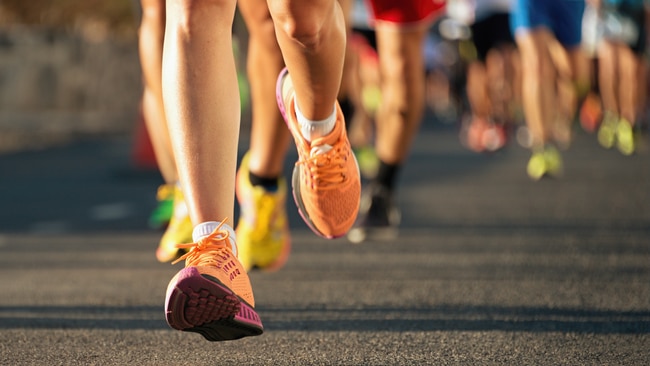‘I tried nasal breathing while running - here's how it went'
It's harder than you think

Lifestyle
Don't miss out on the headlines from Lifestyle. Followed categories will be added to My News.
When a running coach says this one particular thing will “open up a whole new doorway to your running potential”, if you’re a runner, you’re gonna sit up and listen. Even if that one thing smells too good to be true.
As the co-founder of one of Sydney’s biggest run clubs, I’ve almost heard it all when it comes to running fads and trends. But when this one thing began popping up time and time again, I knew I had to give it a go.
“Before I started nasal breathing, I didn’t pay much attention to my breathing,” Evangline Clayton, one of my Run Leads at the Coogee Run Club, tells Body+Soul. “I was new to running and running was just really hard work. Then I got more into heart monitoring and slowing down and nasal breathing, which stopped me from running too fast and too hard. Now I get way less puffed out, I’m able to run for a lot longer, and I enjoy my runs sooo much more.”
With a review that glowing, I headed straight to an expert for more information on how this technique could improve my performance, recovery and mindset before I closed my chatty trap and gave it a go.
What is nasal breathing?
Exactly what it sounds like, according to running and triathlon coach Josh Coldray from Coldray Endurance. Breathing through the nose and keeping your mouth shut.
“It sounds really simple right?” he puts to Body+Soul. “Because that’s what the nose is there for, it’s made to breathe. But the majority of us don’t do it, or at least not as much as we should, and we just breathe through our mouths.”
Which means that we’re essentially sucking in cold dirty air. Because unlike the mouth, the nose cleans the air, gets rid of the dirt and heats the air up, meaning that the oxygen we breathe in through our nose is going to be a lot healthier and a lot better quality, while better oxygenated blood is sent on to our lungs and muscles.

What are the benefits?
Stay with us here, but Coldray wants you to picture your pets. “If you look at a dog, a dog breathes through its mouth,” he says. “It’s panty and dogs tend to be quite anxious, nervous and excited creatures. Whereas if you look at cats, they’re predominantly nasal breathers and they’re very calm, chilled and relaxed.”
And this relates to humans as well. “You’ll find that nasal breathing, regardless of exercise, helps to keep your mind calm, make you a lot more present, feel less anxious, sleep deeper, wake up feeling fresher, and you have better clarity, focus and concentration.”

Then when it comes to running, well the results are phenomenal. “I’d say the most important thing is that your working muscles will receive more oxygen,” the coach explains. “In fact, you'll receive up to 20 per cent better oxygenated blood, which means you’re going to be able to perform stronger for longer and more efficiently. Breathing will also be a lot more efficient – up to 22 per cent more efficient, which is massive.”
Then there’s the quicker recovery. “Through nasal breathing, you’ll reduce the chance of injuries because you’ll be breathing less fast into your chest and more into your lungs, filling them up,” says Coldray. “And because you'll be breathing slower, everything just tends to stay a little bit looser, while strengthening your core, spine and pelvis.”
Throw in the fact that your nervous system will be more balanced, reducing performance anxiety and stress, while you’re feeling more present and focused with a greater sense of clarity while you’re running, and I can almost taste that “flow state”.

Tips for nasal breathing
#1. Begin when you’re not exercising
“In terms of actually learning to nasal breathe, I'd actually start by practicing nasal breathing when you’re not running,” encourages the coach. “So just while you’re sitting still or walking, keep your mouth shut and breathe through your nose. Try not to take big explosive breaths but just nice light breaths, and just try to slow everything down to a level where you kind of feel that air hunger.”
#2. Fill your lungs up while running
Time to put your practice into action while running (and that’s nice easy runs, not hard interval sets). “Try to keep your mouth closed and breathe in and out through your nose, but with a real focus on making these breaths deep and slow,” Coldray explains. “So really fill your lungs up and don’t take a breath every second, but try to make your breaths long and slow.”

#3. Get used to air hunger
“It takes a little while for the body to adapt to nasal breathing because we're so used to breathing through our mouths the second our heart rates go up,” the running coach says. “The reason we do that is because we try to avoid air hunger, which is when the carbon dioxide increases in your blood, which pushes more oxygen to your blood. It's not that you're suffocating, it’s that your brain is not used to that sensation and you can get that feeling of starvation. So be aware of that as you start running and breathing through the nose.
“Eventually, with more and more nasal breathing whilst running, your lungs will be able to extract more oxygen from the air that you breathe and from there you won’t feel as much hunger and you'll be better oxygenated.”
#4. Be patient and persevere
“If you can practice nasal breathing for a good six to eight weeks, that air hunger will subside,” Coldray says. “It will go, your body will adapt, and then your breathing will become lighter and more efficient, and it will be a lot easier to breathe through the nose all the time, not just whilst you're training.
“But I think you've also got to be aware that when you do first make the switch, everything will feel different. It'll feel hard. So you have to be patient with it. You have to give the body time to adapt.”

#5. Slow it down
“If you’re finding it difficult to breathe through your nose during exercise and you’re really struggling, then all you need to do is just slow the pace down until your breathing is normalized and then you can just get back into it again,” encourages the coach. “But like I said, the more that you do it, the quicker your body's going to adapt and then it will just become like second nature for you.”
#6. If in doubt, try tape
You can also tape your mouth shut. Either while you’re running or sleeping. “You might look like a bit of a wally, but it really, really helps to just stay activated to the nose,” Coldray says.
#7. Make nasal breathing part of your lifestyle
“I think you could easily look at nasal breathing as the big picture as well,” he explains. “Like when you're on the train going into work just focus on taking these deep, slow breaths and that’s just going to make you more preset, get into a more meditative state, and help you react better in situations.”

Giving it a go
For someone who chats a lot while running, I thought keeping my mouth shut would be the hardest part of nasal breathing. But then it hit my chest. The air hunger. Trying to switch up something that you do without thinking is hard, and so is getting out of your body’s comfort box. But while my first go was a struggle – I had to keep reminding myself to breathe through my nose only – it brought with it a serene sense of calm, and drew my mind back to the experience.
So sure, it might take me a few more goes to get it right, or heck maybe even a few months, but I’ve been inspired to keep plugging ahead.
“Nasal breathing has just opened up this whole new doorway to my running potential,” Coldray tells Body+Soul. “I think it's very easy to get to a stage where you’ve been running for a couple of years and you kind of plateau or improvements are very, very, very gradual, which is completely normal. But then you find that there's this whole new kind of running topic to explore where you could see so many improvements.”
More Coverage
Originally published as ‘I tried nasal breathing while running - here's how it went'



